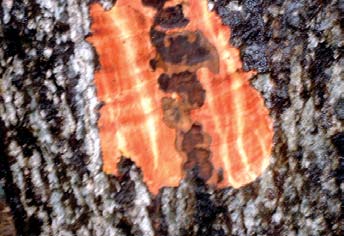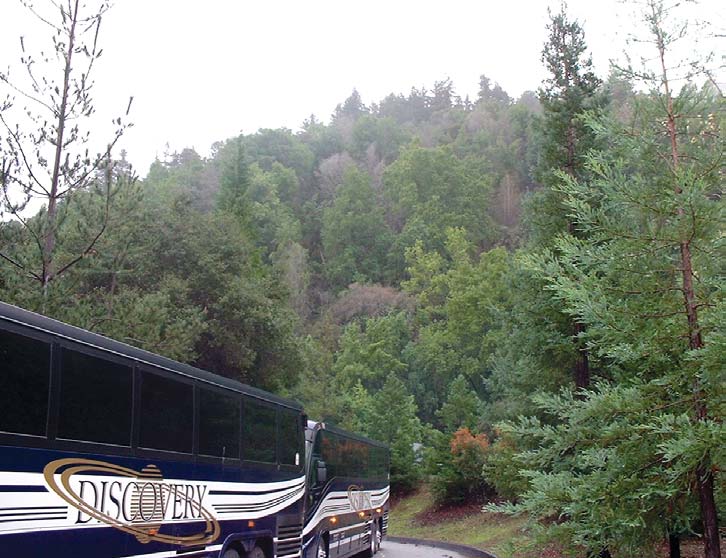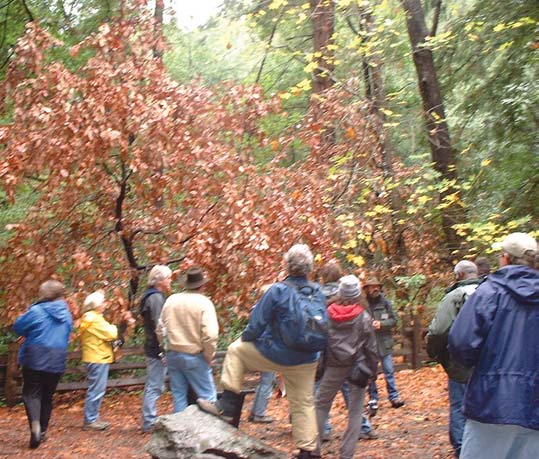PESTS AND DISEASES OF FORESTRY IN NEW ZEALAND
Symposium highlights biosecurity risk from sudden oak death
From Biosecurity Issue 41, February 2003.
The tree disease sudden oak death (SOD) could have a severe impact on New Zealand’s urban or native forests if it became established here. During December 2002 Dr Michael Ormsby, National Adviser for import health standard development in the Forest Biosecurity group, caught up on the latest knowledge on the disease at a research symposium held in Monterey, California.

The sudden oak death science symposium, The State of Our Knowledge, was designed to bring together scientists from throughout the world working on Phytophthora ramorum and the phenomena popularly known as “sudden oak death”. The goal was to provide a scientific overview on the state of knowledge about sudden oak death in forest, woodland, urban forestry, and agricultural settings.
The symposium coincided with a general meeting of the California Oak Mortality Task Force (COMTF), and an informal meeting of the wood packaging sub-committee of the research committee of the North American Forestry Commission, both of which Dr Ormsby was also able to attend. Just under 300 researchers, managers and policy makers attended the symposium, mostly from the United States, but also from the EU, Canada, Mexico and New Zealand.
The symposium began with a visit to the Pfeiffer Big Sur State Park in Monterey County. The sudden oak death disease was found in the Big Sur State Park area in 1994-95 and has now spread over a large part of the park.
Oak tree mortality in infested areas has been high with an estimated 95% of host trees infected.
A park ranger explained to the group that during the summer season over 1,000 people stay overnight in the park.

As will be explained later, infected soil picked up by these visitors and moved to other suitable areas is believed to be the main agent of spread of the disease within California.
Threat to New Zealand
Just prior to the symposium the Ministry of Agriculture and Forestry (MAF) issued emergency measures to help reduce the chances of the causal fungus of SOD, Phytophthora ramorum, establishing in New Zealand. These measures now mean that importers of host plant material must ensure they source their material from areas known to be free of the SOD disease or P. ramorum.
The measures included a list of areas considered by MAF to be infested with SOD and a number of “buffer counties”surrounding infested counties in California and Oregon. During a presentation at the symposium Shane Sela of the Canadian Food Inspection Agency described New Zealand’s measures as “odd”. An analysis of measures taken by other countries such as Australia, however, show that these measures compare favourably with the measures taken by other regulatory agencies.
The use of buffer counties by MAF was an attempt to allow for the undetected spread of SOD from infested areas in Oregon and California. As these States rely on aerial surveillance to identify infested areas, and aerial surveillance is unlikely to detect new infestations for one or more years, the buffer counties do seem to be appropriate. MAF will now also consider including high-risk areas on the East Coast of the United States in the list of places considered possibly infested by SOD or P. ramorum.

The threat to the New Zealand environment from SOD will only be fully understood should the disease establish and begin spreading within New Zealand. Several factors suggest, however, that we should take seriously our efforts to keep this disease out of New Zealand. The large host range of P. ramorum, the high level of pathogenicity to many of the host plants, and the ability of the disease to spread with relative ease, all suggest that this disease could well be a threat to New Zealand’s urban or native forests.
Future phytosanitary measures
It was clear from the symposium that much work still needs to be completed on the epidemiology of SOD disease.
New host species are being identified at regular intervals and further survey work may well find the disease in new and varied environments. MAF will continue to monitor the progression of this disease in North America and Europe, and will update the phytosanitary measures for the host plants, as new information becomes available.
SOD Symposium highlights
Congressman Sam Farr of Monterey, California officially opened the SOD symposium, reminding participants that funding would always be allocated first to higher priority areas, and the build up for the impending war on Iraq (estimated to potentially cost as much as $US 2 trillion) could see funding all but disappear in 2003.
Dr Dave Rizzo, University of California, Davis, Dr Matteo Garbelotto, University of California, Berkely, and Don Gasser, Pacific Gas and Electric Company provided participants with a brief overview of where the understanding of SOD is today. The overview described the progression of SOD world-wide from the first discovery of the causal fungus, Phytophthora ramorum, in Europe in 1993, to the identification of this fungus as the cause of SOD in California and the subsequent research into its many host plants.
P. ramorum is now known in many countries of Europe and in the states of California and Oregon in the United States. SOD in California was described as an emerging disease.
Three possible scenarios were offered for appearance of SOD in California:
- A recent introduction from another country;
- Formed by hybridisation or mutation of related Phytophthora species; or
- An existing pathogen producing a greater impact after a change in the environment of the infested areas.
Further research is required to determine which is the most plausible origin of the SOD disease.
SOD and the response: management
The California Oak Mortality Task Force (COMTF) was established to oversee and coordinate the allocation of $US24m in funding for the Californian response to SOD. Over 80 research and regulatory organisations are currently involved in the programme.
An interesting comparison can be made to the Painted Apple Moth (PAM) eradication programme currently being managed by MAF. The PAM programme involves around twice the level of funding but only about one-sixth of the number of research and regulatory organisations.
SOD has also been found in Oregon at eleven small sites in Curry County, where a small team of researchers are attempting to eradicate the disease before it can become established.
Surveying for SOD is currently being undertaken from aircraft. Surveyors identify groups of dead trees from the air and follow up with ground sampling where they can get access to the trees (permission must be obtained from private landowners). This method of surveying is unlikely to detect an infestation for at least one to two years after establishment of the disease in the area. Surveys for SOD have yet to be undertaken in other high-risk areas of the USA such as in the east coast oak forests of North Carolina and Virginia. Detection of SOD by aerial survey in these areas may be less effective if disease expression takes longer in conditions less suitable for the growth or spread of the causal fungus.
SOD and the response: epidemiology and ecology
Everett Hansen of Oregon State University described the SOD phenomenon as “one pathogen, three diseases, many hosts”. Current understanding is that the one pathogen, P. ramorum, causes three diseases:
- sudden oak death (SOD) on oaks and tanoak
- ramorum shoot dieback on rhododendron and madrone, and
- ramorum leaf blight on folia hosts (e.g. California Bay laurel).
To date over 45 hosts have been found – around 75% of the plant species tested.
A number of speakers at the symposium considered it possible that serious SOD infestation may be restricted to the “fog belt” area running up the coast of California and parts of Oregon. A preliminary SOD risk or hazard map of the United States was provided at the meeting, showing areas that are believed to have suitable environments and host plant availability for SOD establishment and spread. The map included large areas on the East Coast of North America. It was also noted, however, that as the number of identified hosts species increases, the number of areas or environments likely to become infested with SOD also increases.
Symptoms of SOD on oaks and tanoak in California include trunk cankers and canker bleeding. While the girdling of the trunk by these cankers leads to tree death, no spores could be produced in the lab from isolated cankers. By contrast, in suitable conditions spore formation occurred on the leaves of California Bay laurel (Umbellaria californica), within three weeks of inoculation.
It was suggested that disease severity and spread within forests may be related to the availability of folia hosts which act as sources of inoculum. In California the predominant folia host found associated with most zones of oak dieback caused by SOD is California Bay laurel, otherwise known as Oregon myrtle. Spores produced on the leaves of these understory trees are washed by rain onto the trunks of nearby oak or tanoak species. These oak trunks then become infected, cankers develop and in most cases the trees eventually die.
In Oregon, Californian Bay laurel (or Oregon myrtle) has not been found to be a source of inoculum for locally infected tanoak. For reasons yet to be understood the epidemiology of SOD in Oregon seems to be different from SOD in California. A local species of rhododendron found to be susceptible to P. ramorum might play a more important role in the spread of SOD in Oregon.
The long-distance spread of SOD in California is most likely the result of the movement of soil or organic matter contaminated with spores of the causative fungus, P. ramorum. With the high number of people moving through infected areas such as state parks, and the subsequent contamination of their shoes or vehicles with infected soil, speakers at the symposium considered it likely that SOD has spread to other areas containing suitable hosts and climate (e.g. Sierra Nevada, East Coast).
In Europe, species of oak (Quercus) and beech (Fagus) have been found to be susceptible in laboratory testing. Anecdotal evidence suggests, however, that environmental differences between Europe and California, such as climate and host-plant distribution, may mean that trees of these important genera in Europe are not susceptible in nature.
Dr Michael Ormsby,
National Adviser Import Health Standards, Forest Biosecurity

 Farm Forestry New Zealand
Farm Forestry New Zealand

